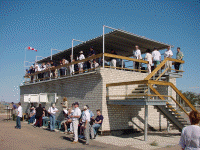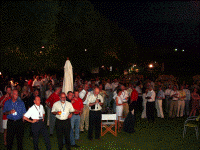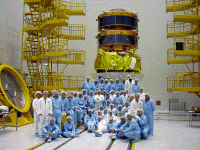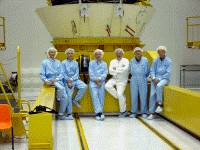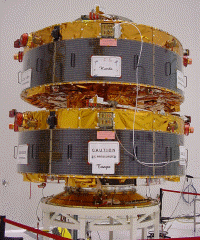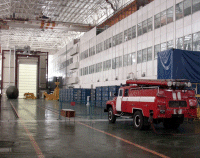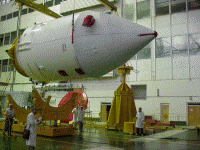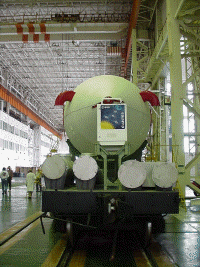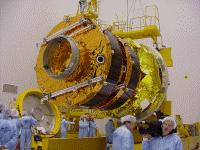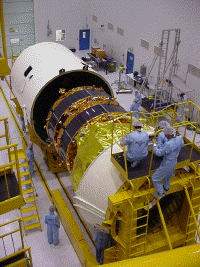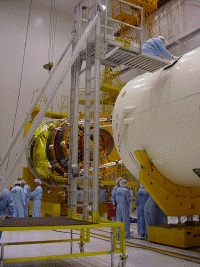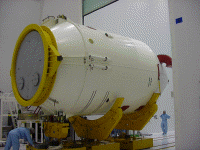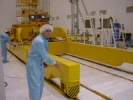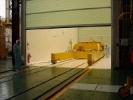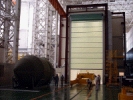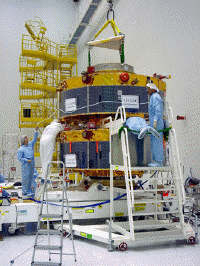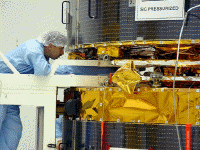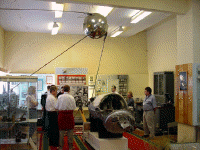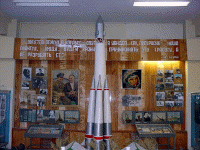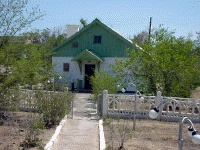Launch Campaign
Liftoff from Kazakhstan
Cluster II was launched from Baikonur Cosmodrome in Kazakhstan on 16 July 2000 and 9 August 2000. The four satellites were put into orbit, in pairs, by two Soyuz rockets provided by the Russian-French Starsem company. Starsem has four shareholders - Aerospatiale, Arianespace, the Russian Space Agency and TsSKB Samara, the manufacturer of the Soyuz vehicle.
The Soyuz is a more powerful version of the rockets that launched the world's first satellite in 1957 (Sputnik) and the first spaceman in 1961 (Yuri Gagarin). Between them the various versions of the booster have completed more than 1600 successful launches. Although the Soyuz first flew in 1963, it is still used to orbit both manned and unmanned spacecraft. Its future operations will include delivering crews and cargo to the International Space Station. Liftoff of a Soyuz launcher from Baikonur.
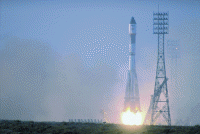 |
|
Liftoff of a Soyuz launcher from Baikonur |
When the Cluster II mission was approved by ESA's Science Programme Committee in April 1997, it was decided that a launch on a European Ariane rocket would be too expensive. The only feasible solution, bearing in mind the project's strict financial constraints, was to launch the spacecraft using two Soyuz launch vehicles, each equipped with a newly designed Fregat upper stage. The contract for launch of the Cluster II satellites was signed on 24 July 1998 at ESA Headquarters in Paris.
The first pair of Cluster II satellites lifted off on 16 July 2000, and were followed by the second pair one month later. This gap allowed fewer people to be used for mission control in the European Space Operations Centre (ESOC) in Darmstadt (Germany).
Cluster Launch Campaign
Preparations
The first members of the Cluster II launch campaign team arrived in Baikonur on 27 April 2000. The 33 strong team included staff from Dornier Satellitensysteme, Matra-Marconi Space, TGI (spacecraft support), Europassistance (medical support), Starsem (launch services) and ESA.
Over the weeks building up to the Cluster launch, the team worked hard to ensure the satellites were fully assembled and in perfect working order. Members of the ESA Cluster II team regularly reported on their progress, their entries can be read in the Baikonur launch campaign diary.
After the successful launch of the first Cluster pair, Project Manager John Ellwood praised the Cluster team saying, "Everyone on the ground has done a fantastic job. It has been a very hard working environment, with a lot of working even on Sundays. It is largely due to the tremendous efforts of the ESA team and the industrial consortium led by Astrium GmbH that we are in this excellent position today."
'Name the Cluster quartet' competition
Members of the public in all of ESA's 15 member states were asked to suggest the most suitable names for the Cluster II spacecraft. The satellites were known only as flight models (FM) 5, 6, 7 and 8.
 |
|
The winner of 'name the cluster quartet' competition (4th from the left), Raymond Cotton from Bristol (UK) |
After sifting through more than 5000 entries from all over Europe, and debating at length the merits of the various suggestions, the multinational jury eventually produced a list of 15 national prize winners, one from each ESA member state.
The winning names for the four spacecraft were announced at the ESOC event to mark the first Cluster II launch. The lucky overall winner was Raymond Cotton, a civil servant from Bristol in the UK. Raymond's winning names for the individual Cluster satellites were Rumba (FM 5), Salsa (FM 6), Samba (FM 7) and Tango (FM 8).
"I am very surprised and pleased," said Mr Cotton. "We thought of these names because my wife and I both like ballroom dancing, and they seemed to fit with the movement of the satellites through space. The names are also international and will be recognised in any country."
Launch of Salsa and Samba
The first Cluster pair, Salsa and Samba, were launched from Baikonur on 16 July after an initial attempt the previous day was aborted in the final minute of the countdown. Project Manager John Ellwood was watching the launch from the viewing area just 1 km away from the launch pad.
 |
|
Lift-off for the first Cluster pair. Baikonur, 16 July 2000 |
"There was a crackling roar as the vehicle was held down for 20 seconds while its engines went to half thrust - it almost looked as if it was struggling to escape. Lift-off was quite slow, but it accelerated very quickly. At first it seemed to rise vertically, but then it turned as it headed into the distance."
"We were still in contact with the Starsem people in the bunker and they gave us a 'countdown' on how things were going every 10 seconds - every time it was absolutely nominal. It was a major relief once we knew that the first Fregat burn had gone OK and the satellites were in orbit."
Launch of Tango and Rumba
As scheduled, on 9 August 2000 at 17:13 local time (13:13 CEST), the Soyuz lifted off from pad 6, carrying the second pair of spacecraft in the Cluster quartet. Hundreds of scientists around the world watched with bated breath as the vehicle soared into a clear blue sky with its precious payload.
 |
|
Lift-off of Soyuz launcher carrying the second Cluster pair, Baikonur, 9 August 2000 |
Although the Fregat and its Cluster satellites, Rumba and Tango, were safely installed in their initial preliminary orbit, some 200 km above the Earth, one more vital manoeuvre remained - the second burn of the Fregat main engine. This major landmark took place out of contact from ground stations as the upper stage passed over Africa.
Spontaneous clapping from everyone concerned marked the announcement by Alan Smith, Cluster Mission Director at the European Space Operations Centre in Darmstadt, Germany, that the ground station in Kiruna (Sweden) had acquired signals from both Rumba and Tango. The second Cluster pair had separated from the Fregat and were following their individual elliptical paths which took them between 250 and 18 000 km above the Earth.
 |
 |
|
Alan Smith, Cluster Mission Director at ESOC, Darmstadt |
VMC image of Cluster (Tango and Rumba) separation |
About three hours after launch, the 430 gram Visual Monitoring Camera (VMC) attached to the base of Cluster spacecraft FM 5 (Rumba) sent colour pictures from space showing the separation of the two unmanned satellites. The series of 27 images taken 3 seconds apart show the lower spacecraft (FM8 - Tango) spinning away against the background of the blue and white Earth.
Cluster press event, Royal Society London
During the second Cluster launch a special media event was held at the Royal Society in London, several hundred VIPs and guests responded enthusiastically to the afternoon's events.
In a statement read by Dr Ian Corbett, Director of Science of the UK Particle Physics and Astronomy Research Council, the UK Science Minister Lord Sainsbury said, "This is a major achievement for ESA and its partners, particularly following the tragic demise of the first mission."
"We've done what we promised we would do in 1996," said John Credland, ESA's Head of Scientific Projects Department. "It's fantastic."
"I am tremendously pleased to be here and watch such a perfect launch," said Colin Hicks, Director General of the British National Space Centre.
 |
 |
 |
|
Colin Hicks, Director General of BNSC |
John Credland, ESA Head of Science Projects |
Howard Nye, ESOC Ground Segment Manager and Katie Haswell, presenter |
Cluster Project Scientist Philippe Escoubet paid tribute to the scientists who had endured the long wait before their hard work came to fruition. "It's a big day for the science world," he said. "Some of the scientists have been working on this mission for 15 years. They have overcome adversity to revive Cluster and raise it from the ashes." With a broad smile he added, "We're now looking forward to bringing the quartet together, commissioning the experiments and then analysing a flood of exciting data over the next two years."
 |
 |
|
Dr Andrew Fazakerley, Principal Investigator for PEACE and Katie Haswell, presenter |
Philippe Escoubet, ESA Project Scientist and Katie Haswell, presenter |
Nominal orbital manoeuvres
Cluster II launch, second pair 09 August 2000
Spacecraft FM 5 (Rumba)
|
Date |
Time UTC |
Type |
Nominal duration |
Description |
|
2000-08-09 |
15:39 |
10 N thrusters |
92 s |
Initial spin-up from 5 to 14 rpm |
|
2000-08-09 |
21:40 |
10 N thrusters |
25 s |
Slew to apogee raising attitude |
|
2000-08-10 |
03:03 |
10 N thrusters |
- |
Attitude trim tbc |
|
2000-08-10 |
15:14 |
Main engine |
8.9 min |
Apogee raising manoeuvre 1 |
|
2000-08-11 |
04:45 |
Main engine |
10.3 min |
Apogee raising manoeuvre 2 |
|
2000-08-12 |
00:10 |
Main engine |
10.1 min |
Apogee raising manoeuvre 3 |
|
2000-08-12 |
16:33 |
Main engine |
10.9 min |
Apogee raising manoeuvre 4 |
|
2000-08-12 |
23:45 |
10 N thrusters |
22.0 min |
Slew to inclination change attitude |
|
2000-08-13 |
06:40 |
10 N thrusters |
- |
Attitude trim |
|
2000-08-13 |
11:26 |
10 N thrusters |
- |
Attitude trim tbc |
|
2000-08-13 |
16:52 |
Main engine |
17.2 min |
Inclination change manoeuvre |
|
2000-08-15 |
05:25 |
10 N thrusters |
8.6 min |
Slew to operational attitude |
|
2000-08-15 |
- |
10 N thrusters |
- |
Spin-down |
Spacecraft FM 8 (Tango)
|
Date |
Time UTC |
Type |
Nominal duration |
Description |
|
2000-08-09 |
16:04 |
10 N thrusters |
96 s |
Initial spin-up from 5 to 14 rpm |
|
2000-08-09 |
18:40 |
10 N thrusters |
30 s |
Slew to apogee raising attitude |
|
2000-08-10 |
00:11 |
10 N thrusters |
- |
|
|
2000-08-10 |
09:54 |
Main engine |
8.4 min |
Apogee raising manoeuvre 1 |
|
2000-08-11 |
05:49 |
Main engine |
10.5 min |
Apogee raising manoeuvre 2 |
|
2000-08-12 |
00:46 |
Main engine |
10.2 min |
Apogee raising manoeuvre 3 |
|
2000-08-12 |
16:36 |
Main engine |
11.6 min |
Apogee raising manoeuvre 4 |
|
2000-08-12 |
20:40 |
10 N thrusters |
21.9 min |
Slew to inclination change attitude |
|
2000-08-13 |
02:24 |
10 N thrusters |
- |
Attitude trim |
|
2000-08-13 |
08:29 |
10 N thrusters |
- |
Attitude trim tbc |
|
2000-08-13 |
16:50 |
Main engine |
17.4 min |
Inclination change manoeuvre |
|
2000-08-14 |
18:10 |
10 N thrusters |
8.5 min |
Slew to operational attitude |
|
2000-08-14 |
- |
10 N thrusters |
- |
Spin-down |
Cluster II launch, first pair 16 July 2000
Spacecraft FM 7 (Samba)
|
Date |
Time UTC |
Type |
Nominal duration |
Description |
|
2000-07-16 |
18:12 |
10 N thrusters |
94 s |
Initial spin-up from 5 to 14 rpm |
|
2000-07-16 |
23:00 |
10 N thrusters |
52 s |
Slew to apogee raising attitude |
|
2000-07-17 |
11:22 |
Main engine |
10.5 min |
Apogee raising manoeuvre 1 |
|
2000-07-18 |
08:38 |
Main engine |
10.2 min |
Apogee raising manoeuvre 2 |
|
2000-07-19 |
05:15 |
Main engine |
10.0 min |
Apogee raising manoeuvre 3 |
|
2000-07-19 |
23:11 |
Main engine |
9.5 min |
Apogee raising manoeuvre 4 |
|
2000-07-19 |
23:41 |
10 N thrusters |
21.3 min |
Slew to inclination change attitude |
|
2000-07-20 |
11:16 |
10 N thrusters |
- |
Attitude trim |
|
2000-07-20 |
15:21 |
10 N thrusters |
- |
Attitude trim tbc |
|
2000-07-20 |
23:47 |
Main engine |
17.8 min |
Inclination change manoeuvre |
|
2000-07-22 |
00:32 |
10 N thrusters |
8.9 min |
Slew to operational attitude |
|
2000-07-22 |
04:02 |
10 N thrusters |
- |
Attitude trim |
|
2000-07-24 |
12:00 |
10 N thrusters |
tbd |
Drift start manoeuvre |
Spacecraft FM 6 (Salsa)
|
Date |
Time UTC |
Type |
Nominal duration |
Description |
|
2000-07-16 |
18:32 |
10 N thrusters |
96 s |
Initial spin-up from 5 to 14 rpm |
|
2000-07-16 |
21:45 |
10 N thrusters |
39 s |
Slew to apogee raising attitude |
|
2000-07-17 |
11:21 |
Main engine |
10.6 min |
Apogee raising manoeuvre 1 |
|
2000-07-18 |
08:34 |
Main engine |
10.4 min |
Apogee raising manoeuvre 2 |
|
2000-07-19 |
05:08 |
Main engine |
10.1 min |
Apogee raising manoeuvre 3 |
|
2000-07-19 |
22:58 |
Main engine |
9.8 min |
Apogee raising manoeuvre 4 |
|
2000-07-19 |
23:29 |
10 N thrusters |
21.5 min |
Slew to inclination change attitude |
|
2000-07-20 |
13:17 |
10 N thrusters |
- |
Attitude trim |
|
2000-07-20 |
16:57 |
10 N thrusters |
- |
Attitude trim tbc |
|
2000-07-20 |
22:59 |
Main engine |
18.1 min |
Inclination change manoeuvre |
|
2000-07-22 |
00:34 |
10 N thrusters |
8.9 min |
Slew to operational attitude |
|
2000-07-22 |
07:52 |
10 N thrusters |
- |
Attitude trim |
|
2000-07-24 |
12:00 |
10 N thrusters |
tbd |
Drift start manoeuvre |
9th August 2000 (2nd pair)
On the launch mast before the lift off, removing purge lines on the fairing
 |
 |
Inside the bunker few minutes before launch
 |
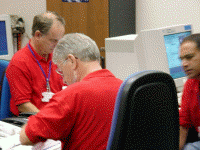 |
|
Image on the right: Gerard Melchior, Launch Campaign Director, assisted by Heinrich Sondermann and Jo Pereira | |
Viewing stand
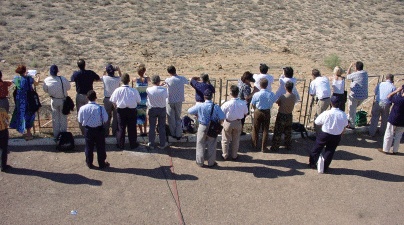 |
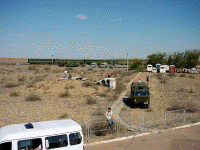
|
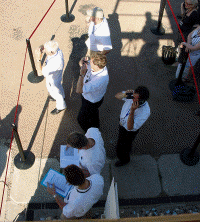 |
|
Image above from right to left: Professor Roger Bonnet, ESA Director of Science, John Ellwood, Cluster II project manager and Alberto Gianolio, Cluster II deputy project manager |
The Communication Cell during the final countdown
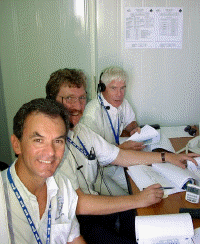 |
From right to left: Professor Roger Bonnet John Ellwood Alberto Gianolio |
One hour after the launch of the second pair of Cluster II spacecraft
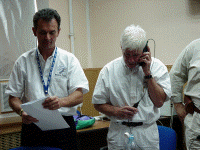 |
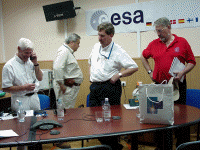 |
|
From right to left: Professor Roger Bonnet (ESA Director of Science) and Alberto Gianolio (Cluster II deputy project manager) |
Getting from ESOC the first information on the success of the mission |
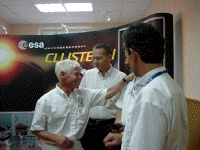 |
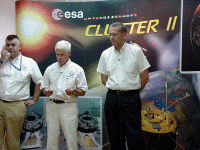 |
|
Professor Roger Bonnet, ESA Director of Science |
Hugo Marie, acting Head of Science Communication; Roger Bonnet, ESA's Director of the Scientific Programme and Jean-Yves Le Gall, President of Starsem |
Launch party at the Sputnik hotel
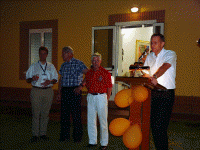 |
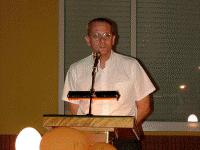 |
|
Speech of Jean-Yves Le Gall, President of Starsem | |
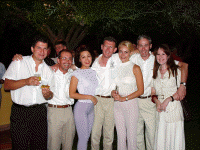 |
6 - 8 August 2000 (2nd pair)
8 August
The only major activities today were for the launcher, none for the spacecraft. Both spacecraft have been switched off and the batteries charged. The purging has also been checked.
 |
 |
|
NPE check with M.Schmidt |
Top of the Launcher |
7 August
Dress rehearsal
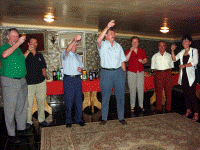 |
|
Toast with from left to right Gerard Melchior; Alberto Gianolio; Roger Bonnet; John Ellwood; Tatyana Suslova; Peter Sachs and Nicole Lamoureux |
The dress rehearsal of the countdown procedure for both the launcher and the Cluster pair was done successfully in real time here in Baikonur with the support of ESOC. Everything went smoothly and without problems. All procedures until lift-off were rehearsed in the following order:
- purging disconnection
- network verification
- Fregat I/F check
- TM switch ON
- S/C switching ON
- but not the critical steps i.e. S/C switching from external to internal power and umbilical drop-off
The launch team (ESA/Astrium) celebrated the successful completion of the dress rehearsal with a Russian banquet with the Director of Sciences R.M. Bonnet, the Cluster Project Manager John Ellwood and the Launch Campaign Director Gerard Melchior.
6 August
Day of roll-out and launcher erection
An early start for the whole team, we left the hotel at 06:30 for the launch pad to witness the roll-out of the Soyuz launcher. With its precious payload onboard the launcher was moved from the MIK40 launcher assembly building to the launch pad. We were joined on the pad by a large group of Russians (workers and officials) who were not scared off by the early wake-up. The roll-out was carried out by train over a distance of about 500 m. The train also had a special wagon providing air-conditioning to the second Cluster pair inside the fairing.
Roll-out of Soyuz launcher from MIK40 building by train
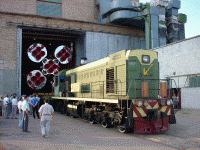 |
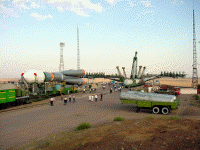 |
|
View of train and launcher and launch pad (in background) | |
Before arriving at the launch pad, the locomotive was removed. The launcher was then moved onto the launch pad on its transport wagon. Once carefully installed and blocked, the rocket was erected on its umbilical mast from horizontal to vertical position, this took exactly 6 minutes!
 |
 |
|
Erection of the launcher onto the launch pad | |
Next the two launch pad platform assemblies, which were opened like flower petals whilst the rocket was put in place, were brought from horizontal to vertical position and the umbilical mast was removed. This was again a very impressive and professional operation done by the Russians for the 1643 consecutive time!
Professor R.M.Bonnet, who attended the roll-out, was very delighted and expressed his satisfaction on the job done so far.
 |
 |
|
Professor R.M.Bonnet |
Campaign Administrator Loic Bourillet raising the ESA flag on the launch pad |
To celebrate the end of the operations, at about 10:30, Loic Bourillet, our Launch Campaign Administrator raised the ESA flag on the launch pad!
Evening: Progress launch
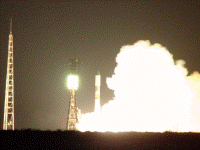 |
|
Lift-off of Soyuz carrying Progress cargo module to the International Space Station (00:26 AM local time) |
The launch was really fantastic as we were especially close to the Soyuz launch pad 5 (less than one kilometre): the brightness of the rocket illuminated the surroundings so much that for a few seconds it seemed like daylight (a bit yellowish!).
1 - 5 August 2000 (2nd pair)
3, 4 and 5 August
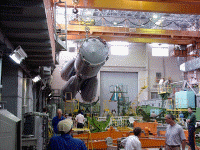 |
|
Hoisting of 1st stage on the launcher transport train (3 August) |
Early Thursday morning a special train took the composite to building MIK40. Over the next 3 days, the assembly of the launcher took place as follows:
- Connection to air conditioning system
- Removal of the rear cover of Fregat
- Mating of composite to Soyuz 3rd stage and associated electrical verification
- In parallel, mating of the 1st and 2nd stage
- Hoisting of the upper composite and the 3rd stage on the transfer train
- Final integration of the complete launcher.
- Spacecraft final arming through the small fairing hatches, disconnection of air conditioning system and transfer to pad on 6 August.
As for all Soyuz launchers since the beginning of the Soviet space era, our launcher has been baptised by an orthodox priest.
Mating of composite to 3rd stage (3 August)
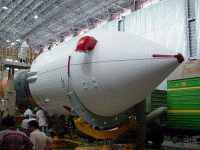 |
 |
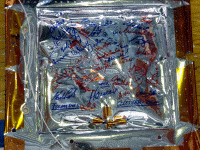 | |
|
The signatures of the whole launch team were collected on a Kapton foil and placed inside the thermal blanket covering the arming plugs. | |
Meanwhile, since 4 August activities have restarted intensively on the launch pad: the bunker and the catacomb of the launch pad have been reactivated after a 2-week hibernation period. The COTE and OCOE systems have been switched on and their link to the mast validated with the S/C simulator. Also, the links to ESOC via the NDIU have been re-established and revalidated.
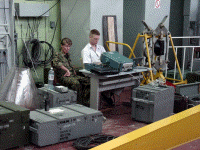 |
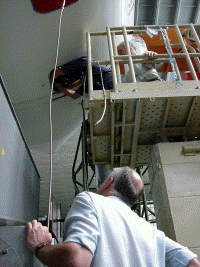 |
|
Above: Launcher electrical verification (4 August) Right: Arming of the spacecraft through fairing hatches under close PA supervision (5 August) (Colin Parkinson, ESA) |
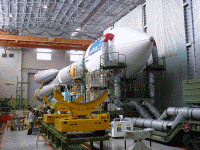 |
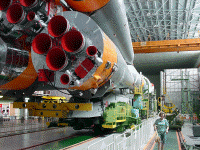 |
|
Launcher completely assembled on the transport train with the air conditioning (5 August) | |
2 August
The Fregat, Cluster pair and fairing assembly have been transferred from the Energia building to the MIK40 building close to the launch pad. The transfer took place overnight as the outside temperature is currently 40oC despite the presence of an air conditioning system. The final assembly of the launcher, including its payload, will take place in this building.
1 August
Today was the last day to see the Cluster pair before they were encapsulated under the fairing. This operation was very impressive but rather fast, taking less than 2 hours! First, the Fregat on its support with the Cluster stack was tilted from vertical to horizontal position in half an hour. Then, the last red tag items, including the hoisting device on top of the Cluster stack, were removed, leaving just the arming plugs in place.
Tilting of the Cluster stack from vertical to horizontal
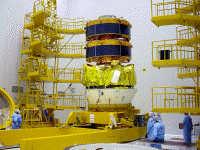 |
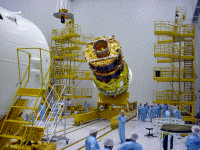 |
Next, the fairing on its support was carefully aligned with the Fregat assembly. Once the alignment was satisfactory, the fairing on its support was moved horizontally towards the Fregat assembly until the Cluster spacecraft started to enter inside the fairing.
 |
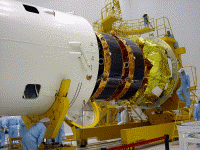 |
After checking correct clearance, under close supervision of the technicians (installed on a special portique, see pictures 8 & 11), the fairing was again carefully moved horizontally until the Fregat and the fairing mechanical interfaces were in contact. After last positioning with centring pins, the Fregat assembly and the fairing weighting were bolted together.
Encapsulation of the Cluster stack
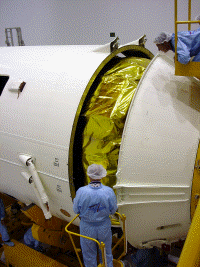 |
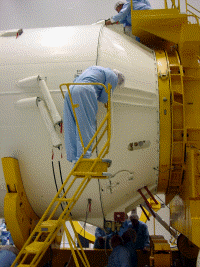 |
The next operation was to connect and check all electrical lines (umbilical and pyro).
Finally the fairing was sealed with a cover on its rear side (under Fregat) in preparation for transport tomorrow.
26 - 31 July 2000 (2nd pair)
31 July
It is the day of the Red Tag items removal for both Fregat and Cluster!
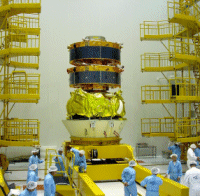 |
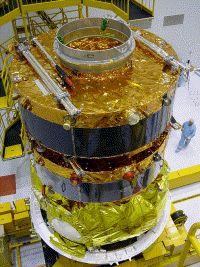 |
|
Superb views of the Fregat/Cluster stack during Red Tag item removal |
These red tag items are non Flight items (such as protective covers, caps, solar array protection, pyro inhibitors; safety plugs etc.) which need to be removed before the encapsulation of tomorrow. Some "official" team pictures were taken during that day!
In view of the encapsulation of tomorrow, the fairing has been brought inside the Upper Composite Integration Facility (UCIF) clean room.
30 July
Day off for most of the team, except the electrical team who has done the pyroline verification and some S/C functional verification after the umbilical lines reconnection, but unfortunately with no real possibility to enjoy activities outside, since several days the temperature is fluctuating between 35 °C during night and 45 °C in the middle of the afternoon. The thermometer installed in front of the hotel door is currently the most watched instrument by our Western eyes that find it hard to believe what is displayed!
29 July
The Cluster stack has been first connected to the Adapteur Charge Utile (ACU) after the successful repair of the connector bracket the day before. Then, electrical validations of the Fregat-OCOE link have been carried out with the spacecraft simulator in preparation of the mating of the Cluster with Fregat foreseen the same day.
The exiting moment of the day was definitely the mating operation of the Cluster stack and its ACU on Fregat. The operation took approximately 3 hours as it has to be carried out in the safest conditions: more than 1200 kg of Cluster propellant are being displaced and put on top of 5350 kg Fregat propellant.
The hoisting operation has to be performed in several steps:
- removal of platforms from Fregat
- hoisting of Cluster stack above Fregat mounted on its support
- reinstallation of the platform for final installation of Cluster stack
- installation and mounting of Cluster stack on Fregat
The lowering of the cluster stack during the last centimetres was controlled very closely by the Lavotchskin people who were not hesitating to climb on the Fregat structure to help to guide the ACU through the mounting screws. Something unthinkable with our Western launchers! But, then it works!
Preparation for hoisting
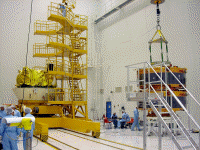 |
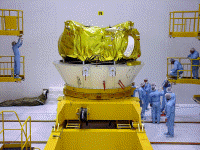 |
Transfer to Fregat
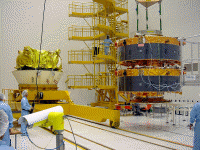 |
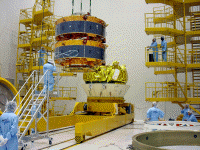 |
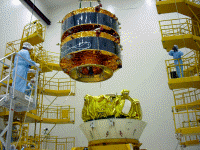 |
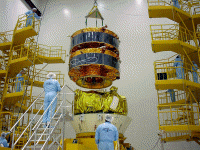 |
Mating of Cluster stack on top of Fregat
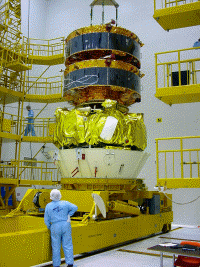 |
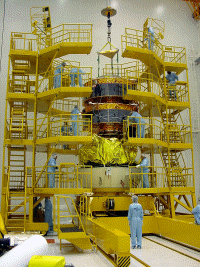 |
|
Cluster stack above Fregat |
Reclosure of Fregat scaffolding |
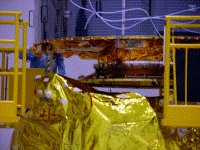 |
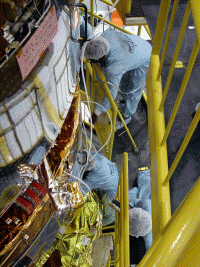 |
|
Above: Last centimetres before contact Right: People on scaffolding for fine guiding of Cluster stack and tightening of mounting screws |
28 July
The fairing has arrived in the Upper Composite Integration Facility (UCIF).
The umbilical connector support bracket has been repaired and reinstalled successfully after 5 days of intensive work. This last-minute action has requested huge efforts and co-ordination
- with Astrium consortium and their subcontractors to manufacture and ship a new bracket from Europe in a very short time and
- with Aerospatiale team in charge of the Cluster stack integration on the ACU (Adaptateur Charge Utile = Flight interface to launcher (Fregat))
- and last but not least with the Russian workshop on the cosmodrome which has provided some metrology and tools for the repair.
This bracket installation has been performed overnight to avoid disrupting the work of the other teams working in the UCIF clean room: the Lavotchkin people working on Fregat (thermal blanket installation)
27 July
Electrical validation of the Fregat link has been carried out with the spacecraft simulator, in preparation of the mating of the Cluster with Fregat foreseen the day after tomorrow.
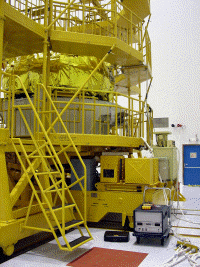 |
26 July
No activities on the spacecraft today. The mechanical team is busy trying to repair one of the two umbilical connector support brackets that has been accidentally slightly damaged, obliging us to reshuffle some of our electrical activities.
17 - 25 July 2000 (2nd pair)
25 July
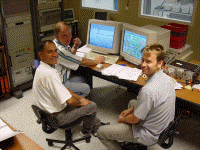 |
|
The electrical team running the AFT (from left to right Heinrich Sondermann (Astrium); Joseph Pereira (ESA) and Tim Norforld (TGI). |
This test is followed by the recharging of the batteries and by the verification of the pyro lines.
Tonight, the Fregat stage, which has been fuelled over the weekend, is due to arrive in our building (the Energia building) for its mating with the Cluster stack at the end of the week.
24 July (evening)
The Cluster stack with Rumba and Tango has been mated onto the Adapteur Charge Utile (ACU), which is our flight interface to the launcher. The stack has been placed onto the ACU with the help of guiding clamps for the last centimetres of the vertical motion. Once installed, the clamp band was mounted around the interface, centred and tensioned. The operation took about 3 hours in total.
Then, the 2 umbilical connectors were connected for extended electrical tests, which are due to take place tomorrow.
22 July
Both spacecraft have been stacked together this afternoon in the Upper Composite Integration Facility (UCIF) clean room. The operation was conducted very smoothly as follows:
- Installation of hoisting device on top of Rumba
- Hoisting of Rumba above Tango
- Lowering of Rumba on top of Tango
- Installation of clamp band between the 2 satellites
- Positioning, centring and tensioning of the clamp band
The installation and tensioning of the clamp band is quite tricky as the workers have to operate on a specially made horizontal platform which gives access to the interface between the 2 spacecraft with a gap not exceeding 40 cm in width.
Hoisting of Rumba above Tango
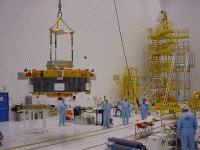 |
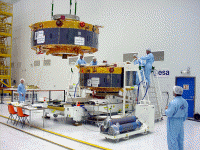 |
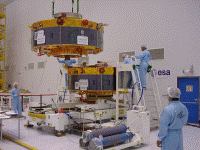 |
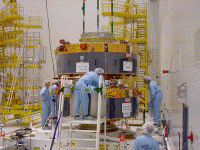 |
Tensioning of clamp band
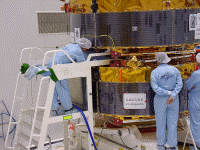 |
 |
|
Tensioning of clamp band with worker laying on the horizontal platform to access the working area | |
21 July
All mechanical, thermal and electrical activities have been completed on both spacecraft, FM 5 - Rumba and FM 8 - Tango, including the pyro line verification, before the stacking. These activities were ended with a detailed inspection of the solar panels.
20 July
The thermal blankets of the lower platform have been closed on FM 8 (Tango). For one engineer from Astrium Dornier, Peter Grossner, it was a rather emotional moment as it was the last blanket he will ever install on a spacecraft before his retirement at the end of the year. In total, he has spent 38 years in Dornier working on all German and most European spacecraft since the beginning of the space era, including Azur, the first German satellite. During the last 12 years, he has specialised in designing, manufacturing and installing thermal blankets on many satellites such as Cluster, Rosat etc.
Installing thermal blanket around connector bracket
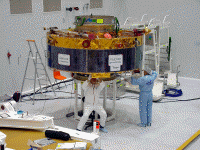 |
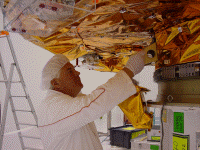 |
Grounding measurements on Rumba
Grounding measurements took place on FM 5 (Rumba) to verify proper mounting of the thermal blankets.
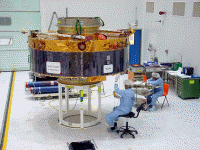 |
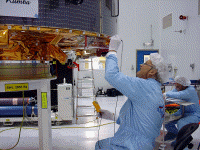 |
In the meantime, some packing work has started for the shipment back of the equipment due to take place end of August.
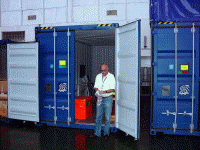 |
|
Andreas Ivady preparing for packing |
19 July
An end-to-end power test was carried out on FM 5 to ensure the correct connection of the batteries. The last red tag items were also removed.
18 July
Same activity as yesterday (battery and final balance masses installation), but this time on FM 5 (Rumba). In the meantime, an end-to-end power test was carried out on FM 8 to ensure the correct connection and functioning of the batteries. Then, the thermal blankets of the lower platform were closed on FM 8.
The team from Aerospatiale who will mount the clamp band on the adapter (ACU) arrived in Baikonur today.
17 July
The excitement of the first launch is now over. The successful launch (confirmed by ESOC) has been duly celebrated with a forced bath in the hotel swimming pool for some of the launch team members before they went back to Europe for a holiday!
The remaining people are now concentrating on the second launch and are already working on the packing of the first items for shipment back to Europe.
The two Cluster spacecraft that are still on the ground are resting on their stands in the Upper Composite Integration Facility (UCIF) clean room. Battery and final balance masses have been installed on FM 8 (Tango).
Countdown for 1st Launch
Countdown events
Legend:
- Time: Hours, minutes, seconds. Nominal times only. All times are subject to alteration.
- Countdown to launch is expressed in Boldface.
Start of countdown
|
03:03:35 |
- 10.10.00 |
Readiness for launch - 10 hours. |
|
03:08:35 |
- 10.05.00 |
Network verifications |
|
03:13:35 |
- 10.00.00 |
Confirmation of FREGAT readiness for beginning of launch day activities |
|
05:13:35 |
- 08.00.00 |
Launcher personnel began operations according to the launch day schedule |
|
05:43:35 |
- 07.30.00 |
Beginning of preliminary check-out of Fregat control system. |
|
06:08:35 |
- 07.05.00 |
Readiness for launch - 7 hours. |
|
06:43:35 |
- 06.30.00 |
Beginning of Fregat TM system verification. |
|
07:08:35 |
- 06.05.00 |
Readiness for launch - 6 hours. |
|
08:03:35 |
- 05.10.00 |
Beginning of FREGAT launch readiness setting. |
|
08:08:35 |
- 05.05.00 |
Readiness for launch - 5 hours. Electromagnetic environment is nominal |
|
08:53:35 |
- 04.20.00 |
Beginning of the State Qommission meeting for launcher fueling authorization. |
|
09:03:35 |
- 04.10.00 |
Readiness for launch - 4 hours. Weather report is received. Authorization from Comission for Launch Vehicle fueling. Temperature under the fairing is normal. |
|
09:08:35 |
- 04.05.00 |
Beginning of Launch Vehicle fueling with propellant components. |
|
10:08:35 |
- 03.05.00 |
Readiness for launch - 3 hours. |
|
10:08:15 |
- 02.45.20 |
Temperatures under the fairing are received. |
|
11:08:35 |
- 02.05.00 |
Readiness for launch - 2 hours. |
|
11:43:35 |
- 01.30.00 |
Temperatures under the fairing are received. |
|
11:53:15 |
- 01.20.20 |
Launch Vehicle is fueled with all propellant components. |
|
12:08:35 |
- 01.05.00 |
Readiness for launch - 1 hour. |
|
12:18:35 |
- 00.55.00 |
FREGAT TM system switched ON. |
|
12:38:35 |
- 00.35.00 |
Readiness for launch - 30 min. |
|
12:43:35 |
- 00.30.00 |
FREGAT readiness for servicing tower retraction. Beginning of servicing tower retraction. |
|
12:53:35 |
- 00.20.00 |
Servicing towers are retracted. Launcher TM system is switched ON. Readiness for launch - 15 min. |
|
12:58:15 |
- 00.15.20 |
Readiness for launch - 10mn. |
|
13:03:05 |
- 00.10.30 |
TAPE ADVANCE I. |
|
13:03:15 |
- 00.10.20 |
Readiness for launch - 5 min. Upper composite Readiness signal is issued. |
|
13:07:15 |
- 00:06.20 |
Ready for launch at H0 - 1 min report. |
|
13:08:15 |
- 00:05:20 |
KEY ON START. |
|
13:08:35 |
- 00:05:00 |
FREGAT transfer to onboard power supply. |
|
13:08:35 |
- 00:05:00 |
PURGING. |
|
13:10:00 |
- 00:03:35 |
TAPE ADVANCE II. |
|
13:10:15 |
- 00:03:20 |
KEY TO THE DRAINAGE. |
|
13:11:00 |
- 00:02:35 |
Umbilical X02 - X01 drop off command. PRESSURIZATION. |
|
13:12:50 |
- 00:00:45 |
AIR CONDITIONING SYSTEM SWITCHED OFF. GROUND-BOARD. |
|
13:13:15 |
- 00:00:20 |
LAUNCH, "ON-BOARD POWER ON". |
|
13:13:18 |
- 00:00:17 |
IGNITION, "OXYGEN". |
|
13:13:20 |
- 00:00:15 |
PRELIMINARY THRUST LEVEL. |
|
13:13:28 |
- 00:00:07 |
INTERMEDIATE THRUST LEVEL. |
|
13:13:29 |
- 00:00:06 |
FREGAT inertial platform release. |
|
13:13:32 |
- 00:00:03 |
FULL THRUST LEVEL. |
|
13:13:35 |
- 00:00:00 |
LIFT - OFF. |
In the case of a hold during the automatic sequence, the spacecraft will stay on internal power.
Post-launch events
Legend:
Time: Hours, minutes, seconds. Nominal times only. All times are subject to alteration.
|
13:13:35 |
+ 00.00.00 |
The command "Lift - off" passed. |
|
13:13:45 |
+ 00.10.00 |
Nominal flight . |
|
13:13:55 |
+ 00.20.00 |
Engines of 1st and 2nd stages operate normally. |
|
13:14:05 |
+ 00.30.00 |
Launch Vehicle control system parameters are nominal. |
|
13:14:15 |
+ 00.40.00 |
Nominal flight. |
|
13:14:25 |
+ 00.50.00 |
Launcher and FREGAT structure parameters are nominal. |
|
13:14:35 |
+ 00.60.00 |
Launcher stabilization is nominal. |
|
13:14:45 |
+ 00.70.00 |
Pressure in engine chambers is nominal. |
|
13:14:55 |
+ 00.80.00 |
Pitch, Yaw and Roll are nominal. |
|
13:15:05 |
+ 00.90.00 |
Flight is nominal. |
|
13:15:15 |
+ 01.00.00 |
Engines of 1st and 2nd stages operate normally. |
|
13:15:25 |
+ 01.10.00 |
Launch Vehicle control system operates normally. |
|
13:15:35 |
+ 01.20.00 |
Cut-off of the lateral booster's engines. Separation of the lateral boosters (118,65 s). |
|
13:15:45 |
+ 01.30.00 |
Engine of 2nd stage operates normally. |
|
13:15:55 |
+ 01.40.00 |
Parameters of control system are normal. |
|
13:16:05 |
+ 01.50.00 |
Pitch, Yaw and Roll are nominal. |
|
13:16:15 |
+ 01.60.00 |
Launcher and FREGAT structure parameters are nominal. |
|
13:16:25 |
+ 01.70.00 |
Launcher stabilization is nominal. |
|
13:16:35 |
+ 01.80.00 |
Engine of 2nd stage operates normally. |
|
13:16:45 |
+ 01.90.00 |
Pitch, Yaw and Roll are nominal. |
|
13:16:55 |
+ 02.00.00 |
Fairing separation accomplished (186.5 s of flight). |
|
13:17:05 |
+ 02.10.00 |
Control system parameters are normal. Lift-off time information. |
|
13:17:15 |
+ 02.20.00 |
Flight is normal. |
|
13:17:25 |
+ 02.30.00 |
Pressure in engine chambers is normal. |
|
13:17:35 |
+ 02.40.00 |
Launcher stabilization is nominal. |
|
13:17:45 |
+ 02.50.00 |
Trajectory parameters are close to nominal ones. |
|
13:17:55 |
+ 02.60.00 |
Flight is normal. |
|
13:18:05 |
+ 02.70.00 |
Engine of 2nd stage operates normally. |
|
13:18:15 |
+ 02.80.00 |
Pressurization of the 3rd stage oxidizer tank was performed. |
|
13:18:25 |
+ 02.90.00 |
The 3rd stage engine started. The 2nd stage engine cut-off. 2nd stage separation (287,27 s). |
|
13:18:35 |
+ 03.00.00 |
Flight is normal. |
|
13:18:45 |
+ 03.10.00 |
Engine of 3rd stage operates normally. |
|
13:18:55 |
+ 03.20.00 |
Launcher and FREGAT structure parameters are nominal. |
|
13:19:05 |
+ 03.30.00 |
Separation of the tail section of 3rd stage (time of separation = 321.83 s). |
|
13:19:15 |
+ 03.40.00 |
Control system parameters are normal. |
|
13:19:25 |
+ 03.50.00 |
Flight is normal. |
|
13:19:35 |
+ 03.60.00 |
Engine of 3rd stage operates normally. |
|
13:19:45 |
+ 03.70.00 |
Pitch, Yaw and Roll are nominal. |
|
13:19:55 |
+ 03.80.00 |
Engine of 3rd stage operates normally. |
|
13:20:05 |
+ 03.90.00 |
Flight is normal. |
|
13:20:15 |
+ 04.00.00 |
Launcher stabilization is normal. |
|
13:20:25 |
+ 04.10.00 |
Trajectory parameters are near to the predicted ones. |
|
13:20:35 |
+ 04.20.00 |
Control system is normal. |
|
13:20:45 |
+ 04.30.00 |
Engine of 3rd stage operates normally. |
|
13:20:55 |
+ 04.40.00 |
Flight is normal. |
|
13:21:05 |
+ 04.50.00 |
Control system parameters are normal. |
|
13:21:15 |
+ 04.60.00 |
Stabilization is normal. |
|
13:21:25 |
+ 04.70.00 |
Flight is normal. |
|
13:21:35 |
+ 04.80.00 |
Engine of 3rd stage operates normally. |
|
13:21:45 |
+ 04.90.00 |
Launcher structure parameters are normal. |
|
13:21:55 |
+ 05.00.00 |
Flight is normal. |
|
13:22:05 |
+ 05.10.00 |
Trajectory parameters are near to the predicted ones. |
|
13:22:15 |
+ 05.20.00 |
Control system parameters are normal. |
|
13:22:25 |
+ 05.30.00 |
Cut off the 3rd stage engine (525.79 s). |
|
13:22:30 |
+ 05.35.00 |
Third stage separation from the nose module (529.22 s). |
|
13:22:35 |
+ 05.40.00 |
End of launcher ascent reportage. FREGAT is injected to the suborbital trajectory. |
7 - 12 July 2000
Wednesday 12 July
Roll-out and installation onto pad
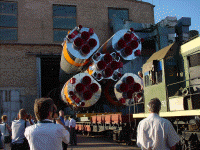 |
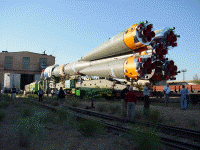 |
Shortly after sunrise, at 7:30 this morning (as always for any Soyuz roll-out since the first one), the doors of the Launch Vehicle Integration Hall opened, and rollout of the launch vehicle to the pad commenced.
A large number of spectators, from the project team as well as from the Russian side, witnessed the vehicle's 30 minute transfer to the pad by train. Once it arrived at the pad, the Soyuz was erected on the pad from horizontal into vertical position, using the hydraulic erector (in no more than 7 minutes). The activity was followed by the anchoring of the rocket to the launch pad, release of the erector and "aiming" of the launch vehicle, i.e. a rotation around its vertical axis in order to achieve the exact azimuth needed for the launch.
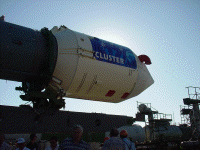 |
 |
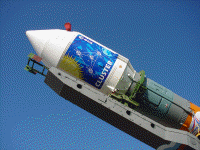 |
Several small activities on the pad then went on until around 10:45, when everybody turned to the west in order to be able to witness the launch of the ISS module Zvezda on a Proton launcher, just 40 km from where we were standing...
Tuesday 11 July
Final assembly Soyuz - upper composite
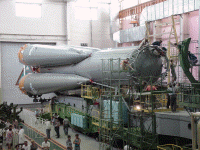 |
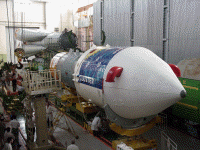 |
The mated "Block I" and UC have been lifted onto the giant hydraulic "erector", to enable their integration with the Soyuz launcher's 1st and 2nd stages. The "Block I" / UC has been in place just millimetres next to the stage 1 - 2 composite using the overhead crane of the facility, a rather high precision activity for such a huge crane.
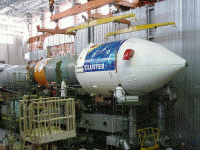 |
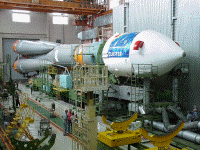 |
The two components were then integrated by 6 bolts. During the flight, these will be cut by a pyrotechnic device to enable separation of "Block I" from the second stage of the launch vehicle.
After completion of this operation by the Russian engineers, the ESA/Dornier team opened two access hatches in the fairing. The "safe plugs" on the skin-connector bracket of both spacecraft had to be replaced by the so called "arm plugs": Both spacecraft are now "armed" and ready for flight, i.e. all their pyros as well as the high voltage experiments are electrically fully connected!
The launch vehicle is now fully assembled in the Launch Vehicle Integration Hall, ready for roll-out to the pad.
Monday 10 July
Installation onto erector
Electrical connections between "Block I" and the UC have been performed. Line checks (continuity) of the electrical links has been validated. The pre-assembled main part of the launch vehicle- the 1st and 2nd stages, consisting of a core body (2nd stage) and 4 strap-on boosters (1st stage)- has been moved onto the giant "erector", where it awaits its mating with "Block I" and the UC.
Sunday 9 July
Upper-composite-Block I Mating
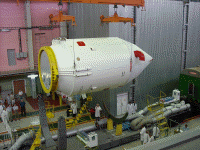 |
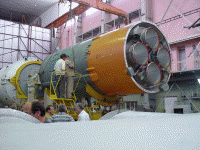 |
The upper composite (UC), consisting of Cluster satellites FM6 & 7, the flight adapter, the Fregat upper stage, the interstage and the fairing, have been mated mechanically with "Block I" - the third stage of the Soyuz launcher. "Block I" stands for injection into an orbital trajectory, as opposed to the ballistic trajectory reached by propulsion stages 1 and 2 of the launch vehicle.
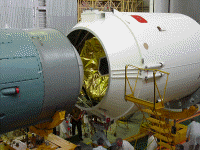 |
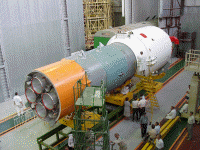 |
To perform this activity, both the UC and "Block I" have been moved onto mobile integration stands by the huge overhead crane in the launcher integration facility (MIK-40). Using these integration stands, the two components were moved within millimetres of each other, and were then bolted together around the circumference of their interface.
Saturday 8 July
No special activities in addition to the previous day.
Friday 7 July
Rehearsal of the launcher countdown. No F6/F7 activities.
Installation of balance masses on F5/F8 and battery conditioning continued.
23 June - 6 July 2000
6 July
Standby of the upper composite in MIK 40. Normal "baby-sitting" activities are performed (e.g. air conditioning and purging).
5 July
Arrival of the train in MIK 40 at 06:00. All nominal.
3 - 4 July
|
The upper composite was transferred from the Upper Composite Integration Facility (UCIF) to a train platform, for later transportation to the "MIK 40" facility for integration onto the Soyuz rocket. |
Departure took place at 21:30 with an estimated time of arrival twelve hours later. To avoid shocks and too much fatigue on the structure during transport, the speed of the train was reduced to less than 10 km/h.
Meanwhile, activities on F8/F5 either go on (spacecraft mass property analysis/report) or are resumed (Propulsion Ground Support Equipment (GSE) cleaning and packing / Battery set up and conditioning).
2 July
Today the upper composite was tilted into the horizontal position and encapsulated into the fairing. This is a very delicate operation and alignment of both the fairing and the composite is the key for a successful operation (expected margins of error were about 4 cm!). Despite that, this operation was performed, once all alignment connections/verifications were made, in about 15 minutes. Fairing installation (left to right, top to bottom):
The upper composite integration is now completed.
1 July
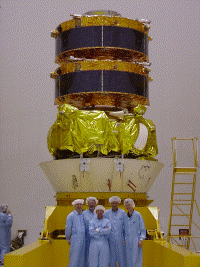 |
After some limited functional and pyro tests, all red tag items were removed (with the exception of pyro lines!)
Preparation of the upper composite, tilting it from a vertical to a horizontal position.
1 July was the last opportunity to see the spacecraft in vertical configuration!
Left: Stack mated with Fregat upper stage, after red tag removal
30 June
Mechanical mating of the Cluster II stack (F6/F7/Adapter) to the FREGAT upper stage. This was followed by the completion of all electrical connections of the "upper composite" (F6/F7/Adaptor/Fregat upper stage).
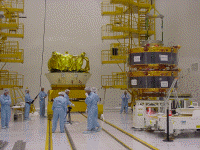 |
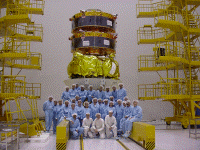 |
27 June
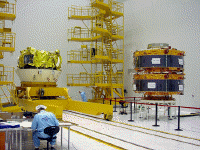 |
The Fregat stage is now inside the UCIF clean room, expecting the next major operation - the mating of the FM 6-FM 7 Cluster II stack - which is due to take place by the end of this week. In the meantime, some minor mechanical and thermal work is performed: installation of thermal blankets; verification and cleaning of the interface for Cluster etc.
26 June
The Fregat stage has arrived inside the Upper Composite Integration Facility (UCIF) clean room. First, its support adapter was rolled out of the clean room via the air lock, then the Fregat stage inside a container was moved inside building 112 on a special wagon. The Fregat container was then hoisted down onto the floor. The container was opened and the Fregat stage transferred and installed on its support adapter. Afterwards, the Fregat stage was rolled inside the air lock of the UCIF clean room, where it was thoroughly cleaned before being moved inside the clean room itself. For that operation, the entire area was evacuated to prevent the various teams from accessing the clean rooms.
Despite the fact that the clean rooms were inaccessible, the FM 6-FM 7 stack had previously been connected via its umbilical, so both spacecraft could be successfully switched on to perform an complete AFT (Abbreviated Functional Test). This AFT test consists in checking the status of the spacecraft by performing short essential tests for the sub-systems and the experiments.
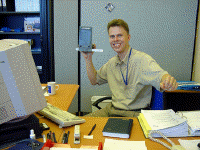 |
|
Markus Ranne |
The leg between Moscow and Baikonur is not a commercial line and the flights are organised by the RKA, the Russian Space Agency. There is normally one flight per week on a Tuesday. In this holiday period, almost all planes are fully booked. Therefore, alternative solutions have to be looked at - finding seats on a Russian military flight or booking a charter flight, possibly in combination with other organisations (e.g. ILS; Energia). This time, the exercise has been exhausting as none of the possible solutions materialised, despite a lot of phone calls, promises etc. - hence the nervousness of Markus!
The spacecraft filling team has started to pack its equipment inside the 20 feet transport container after the successful filling of the 4 satellites last week.
25 June (Sunday)
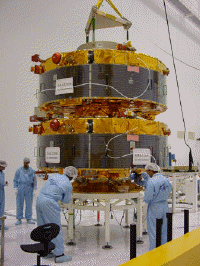 |
Today, the FM 6-FM 7 stack was mated on top of the ACU (Adaptateur Charge Utile) adapter, which is our mechanical and electrical interface to the launcher. Again, this activity was conducted with great caution, as more than 1 500 kg of propellant were up in the air!
First, the stack of the two spacecraft was placed onto the adapter, then the clamp band was installed, positioned and tensioned. Afterwards, the umbilical and pyro connectors were installed, connected and verified. The installation of the connectors was also a delicate task needing some adjustment and patience: these connectors are retractable and need to be plugged-in and unplugged very smoothly.
24 June
For the people who persisted in waking up for a second consecutive day at 4 in the morning, their efforts were rewarded with a beautiful Proton launch at 6:34 (local time). The flight was the first of four scheduled in the coming four weeks, culminating with the launch of Zvezda in mid-July. The launched satellite is a Russian telecommunication spacecraft called Express 3A, built by NPO with an Alcatel payload. The 3-stage Proton vehicle took about 6.5 hours to deliver the satellite to the planned geosynchronous transfer orbit before the spacecraft boosted itself into its final geostationary orbit. The flight took off just after sunrise over the Kazakh steppe, which was really a very nice visual surprise.
 |
After the rush of the 2 days before, the site and the hotel look empty. The departure of the journalist and FRR group was not without its problems, as one of the two buses carrying the 70 people to the Baikonur airport (for their trip back to Europe via Moscow) had its rear axle broken. All the passengers had to pack themselves and their luggage in a single bus and continue their remaining trip to the airport (about 30 km) in the intense heat. That was not the best start for them for their return journey...
The end of the story of the bus is bad: it was repaired during the day and continued its journey back to the city for about five kilometres. Then it stopped again, this time with an engine problem. The next day, it was still in the middle of the road with its engine compartment completely open and the rear wheels dismounted...
A major event for FM 6 and FM 7. Since this afternoon, the twin spacecraft have been stacked together inside the Upper Composite Integration Facility (UCIF) clean room, and they will now remain together until they are placed into orbit. The operation was as follows:
- Installation of hoisting device on top of FM 7
- hoisting of FM7 above FM 6
- lowering of FM7 on top of FM 6
- installation of clamp band
- positioning, centring and tensioning of the clamp band.
The impressive operation took about 4 hours and was carried out with great care, especially during the dynamic phase. The tensioning of the clamp band was not easy as the workers had to operate on a specially made platform between the two spacecraft, which were less than 40 cm apart.
See pictures in chronological order (left-right, top-bottom):
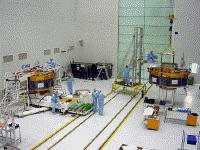
|
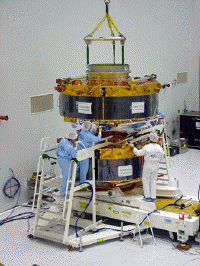
|
23 June
The FFR (Flight Readiness Review) has taken place successfully here in Baikonur. After hearing several presentations on the status of the mission (spacecraft; ground segment; data science centre; Soyuz launcher and Fregat stage), the Board has authorised the Project to continue with the launch preparation activities. The meeting was held in a very good spirit and in a warm atmosphere...not least because of the outside temperature (39 °C)! Some of the participants at the day-long meeting were quite tired, not only because of the jet lag and the climatic conditions, but because some of them awoke very early to attend the Proton launch (4:00 local time) which was finally aborted later that day.
Validation of the links are still going on at the launch pad, but the communications with the people on top of the launch tower, where there is no phone, are not easy by VHF. Therefore, to communicate with the top of the launch tower from the bunker or the catacombs, one had to rediscover the old techniques of communication by signs (semaphore): arms up OK; arms down not OK; arms waving once, telecommand is sent; twice, telemetry is received, etc. At a time of global communication with Internet, old communication means are still used in some areas of the world even for what is supposed to be high tech hardware!
9 - 22 June 2000
22 June
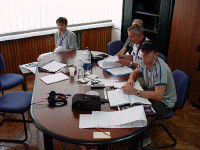 |
|
The control room where the filling activities are controlled with audio and video link by the people from MMS-UK, the safety officer and the nurse |
Mechanical activities are being completed on FM 7, especially the final mass balancing, necessary for such spinning satellite.
A countdown simulation has been performed this afternoon with ESOC (European Space Operations Centre in Germany). Lots of activities are also going on in the offices in view of the Flight Readiness Review, which is taking place tomorrow. This review is going on parallel with the visit to the Baikonur cosmodrome by an important delegation of journalists (about 50) invited by ESA and Starsem, for a duration of 2 days.
21 June
Filling with NTO (oxidiser) has been completed on FM 8 in 1/2 day without any problem: more than 400 kg have been loaded into the spacecraft.
All mechanical and thermal activities have been completed on FM 6: it has been installed on the MPT (MultiPurpose Trolley) for power supply end to end test before the stacking with FM 7 which is due to take place at the end of this week.
In parallel, also in the UCIF clean room, the adapter (the so-called ACU) is prepared for stacking with the verification of the pyro line of the clamp band.
20 June
The battery conditioning is continuing, in a fresh environment for the technicians involved as their room temperature is set at 18oC, which is much better than for the people working on the launch pad tower where the temperature is 40oC!
The validation of the links on the launch pad is still on-going: the telecom and electrical people are encountering all types of classical engineering problems (power breakdown; noise; wrong wiring etc.), which are tackled one by one...which makes the validation a bit longer than foreseen.
In the meantime, we have learned from the Starsem people that the preparation on the Fregat stage is progressing very well: it has been fuelled today and it will arrive next week in the UCIF after final mechanical and electrical checks. The launcher is still in storage in the same building as Fregat. Its preparation for the launch will start only next week
19 June
Preparations are on-going for the filling of FM 5 and FM 8 spacecraft with oxidiser due to start on June 20: MMH drums and equipment are removed and decontaminated. Oxidiser drums have been brought inside the HPF (Hazardous Preparation Facility) clean room.
Thermal and mechanical work is being completed inside the UCIF clean room on the FM 6 and FM 7 spacecraft, with especially final mass balance on FM 6. Verification of the electrical interfaces on the launch pad is still going on.
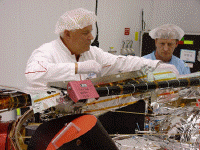 |
 |
|
Completion of thermal work on the boom by Pieter Grossner |
Installation of upper thermal blanket on FM6 |
18 June (Sunday)
First tour outside Baikonur to the recreational area of SBIK, the organisation responsible for the Energia facilities where our spacecraft are prepared for the launch. This area is located 45 km away from Baikonur. It is in an artificial oasis in the middle of the steppe along the Syr-Daria River, which was created 20 years ago by the Russian workers from SBIK. It was extremely appreciated, especially when the outside temperature is 37 degrees.
In the Russian way, with little things, they have done something quite nice: with elements (tanks) of the old N1 rockets, they built houses and dachas, while with other structural elements of the rockets, they provided all facilities for the lake and the swimming pool!
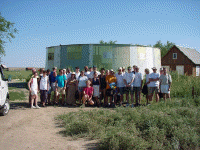 |
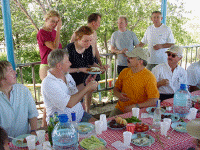 |
|
First tour outside Baikonur to the recreational area of SBIK |
Gerard Melchior, ESA Launch Campaign Director in great discussions with Georg Abt (Astrium).over electrical matters?? |
There was a delicious barbecue with chaslik (local traditional brochettes), beer and vodka.. . and many other things. Also, a lot of activities: swimming in the lake or in the Syr-Daria river; ball games; walking; Russian sauna (in old tradition with wood fire and massage with wild bush branches) and siesta... for those who have not recovered from the barbecue.
17 June
Important day for the telecom links! The link between the spacecraft simulator on the top of the launch pad tower and the bunker, using the Overall Check-Out Equipment (OCOE) via the Check-Out Terminal Equipment (COTE) in the catacombs, has been set-up. The spacecraft simulator is able to receive commands and send data to the OCOE. But further checks and validation are necessary to declare the links fully operational.
This was a rather exciting day, especially with the installation of the simulator and the amplifiers on top of the launch pad at a height of about 40 metres above ground level. The lift and the platforms are quite narrow which made the installation work quite tricky...to say the least ....
People with a tendency to vertigo should avoid it. The view of the surroundings (steppes and launch complex) is quite breathtaking but no pictures were allowed, except for our equipment!
 |
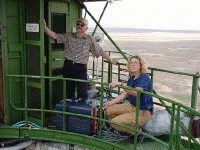
Above: on top of the mast, Frederic Wechsler (ESA) & Liz Haeberle (Astrium) preparing for connecting the spacecraft simulator Left: Launch pad and bunker entrance |
Meanwhile, the second spacecraft of the FM 5-FM 8 pair has been filled with MMH (monomethylhydrazine).
16 June
A visit to the MIK40 building was organised for some of us. The building is located near the launch pad (about 40 km from the Energia building we are using). It is the final integration and assembly building for the Soyuz launcher and its Fregat upper stage. Our launcher is in storage in the building, waiting for the beginning of the launch activities, which are due to start on 27 June.
The Fregat upper stage is currently undergoing mechanical and electrical verification, before its filling and its delivery by train to the UCIF clean room next week where it will be assembled with the two stacked Cluster spacecraft.
Installation of thermal blankets has been completed for FM 6 and FM 7 inside the UCIF clean room.
FM 8 spacecraft has been filled with MMH this morning.
Mechanical and thermal activities have been carried out, including the re-installation of a transponder on FM 7, the removal of the last `red rag' items and the installation of the last thermal blankets.
Meanwhile on the launch pad, all umbilicals, i.e. links between the launch mast and the underground catacombs, are installed and validated. These comprise the umbilical for purging, the ground harness for COTE (Check-Out Terminal Equipment), and the ground harness between COTE and OCOE (Overall Check-Out Equipment) from the catacombs to the (customer) bunker.
15 June
Thermal and mechanical activities are continuing in the UCIF on FM 6 and FM 7. This is done in close co-operation with Starsem as we are now in the so-called Combined Operation Phase. Any activity there needs the approval and the presence of the on-site safety/security officer as both spacecraft are fuelled.
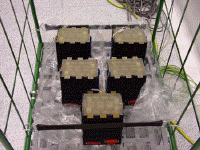 |
 |
|
Top left: 5 Batteries fully conditioned and ready for mounting on FM6 spacecraft Above: Battery mounting Left: Thermal work. Installation of thermal blanket on main engine and on upper platform |
Thermal blankets have been installed around the main engine of FM 6, on some experiments and on the lower and upper platforms. The batteries (5) have also been installed and the FM 6 spacecraft has been successfully switched on to verify the electrical connection.
The FM 5 and FM 8 spacecraft are being pressurised with helium in view of the filling due to start tomorrow.
14 June
The rocket fairing has arrived in the Energia building. It has been transported next to the UCIF clean room, which it will enter in a few days after being cleaned.
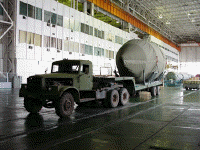 |
 |
|
The rocket fairing has arrived |
The rocket fairing |
The Payload Processing Facility (PPF) clean room is going to be closed for Cluster spacecraft related activities. The last satellite, which needed activities in this room, FM 5 is ready. It has been equipped with the gas boosters, which arrived the day before. It was then transferred to the HPF clean room where it joined FM 8 for the preparation of the propellant filling operations, which will be conducted in parallel on the 2 satellites as it was done for FM 6 and FM 7.
FM 6 and FM 7, already full of propellant, have been in the UCIF clean room since the beginning of the week. They will be stacked together beginning of next week.
13 June
One of the largest groups (19) of the ESA/Astrium team has arrived in Baikonur by Clintondale charter flight. On board, there was a very precious parcel containing the second and last batch of gas boosters for the FM 5 spacecraft.
When boarding in Moscow (at Sheremenievo 1 airport), we met the French photographer Brice Fleutriaux, leaving for Paris with a delegation of high ranking French diplomats, including the French ambassador in Russia. Brice was just released the day before, after an 8 month kidnapping in Chechnya by some rebels. Despite his long isolation period, he looks quite well and was quite interested to learn that ESA was working in Baikonur with the Russians for launching scientific satellites! He was bit up in the clouds after having met the Russian president Putin!
12 June
Both fuelled spacecraft (FM 6 and FM 7) were transferred, one after the other, from the Hazardous Processing Facility (HPF) clean room to the (UCIF) clean room area using a special trolley.
 |
 |
Monday night, we get some exercise to get rid of our stress and try to practise our Russian!. There was a football game organised between the Cluster II team and SBIK (Russian company responsible for operating the Energia Facilities) which took place at 20:00.
The core of the Cluster II team was formed from the Astrium Propulsion Team (formerly known as MMS-UK). They were supported loudly by some ESA, Astrium Gmbh and Starsem players.
Before the game the referee's briefing took place (in Russian, but football is international!) and this was followed by the traditional handshakes by the teams. In the beginning the SBIK team started strongly and scored twice before the Cluster II team warmed up. Both teams were technically excellent but in the end the lack of replacement players (teams were allowed to exchange players on the field freely) started to wear the Cluster II team out and this caused some mistakes on their part.
Although the game was very physical, everything happened in good spirit and there were no injuries. The match ended with a final score of 6 - 4 for the SBIK team. Revenge next week, same day, and same time!
9 - 10 June
- Cluster FM 6 and FM 7 spacecraft are filling with MMH (monomethylhydrazine). Electrical validation in the Upper Composite Integration Facility (UCIF) is due to start as soon as FM 6 and FM 7 spacecraft are moved there next week.
- conditioning is still on-going in preparation for the first 2 sets of flight batteries to be mounted on FM 6 and FM 7 the week after.
- alignment activities are now completed for all spacecraft after the thruster alignment of FM 5.
22 May - 8 June 2000
8 June
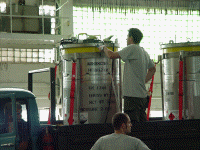 |
|
Before and after moving, both empty and full containers were checked for leaks with a vapour detector |
Today, after finishing filling of the FM 6 and FM 7 spacecraft with the NTO oxidiser, it was time to remove the empty NTO containers from the HPF and replace them with MMH fuel containers. At the same time additional helium bottles were transferred to the HPF.
Even though this operation is not performed inside the HPF, it is considered as a hazardous activity. This is the case for all activities, which involve moving the NTO or MMH containers. A fire truck was standing by ready to intervene if necessary.
A Starsem team performed the transfer of the MMH containers, under Astrium Propulsion and ESA supervision, up to the airlock door, then the Astrium team took over the work and moved the fuel inside the HPF.
7-8 June
Alignment activities are completed on FM8.
FM7 has been filled with NTO oxidiser. The NTO drums are then removed and the MMH (monomethylhydrazine) propellant drums are installed in the HPF.
A flasher test has been performed on the FM 8 spacecraft. Battery conditioning of FM 6 and FM 7 is still nominally on-going.
6 June
Some relief! The FM 7 transponder came back to Baikonur, with the charter flight carrying part of the ESA and the industrial team, after having revisited the Western part of Europe for a period of 1 week! It had suffered a small anomaly (low-power output) which required some verification and a minor repair in Spain, where it was developed.
Its trip from and back to Baikonur via Moscow and Amsterdam was the trickiest part of this hurried action, which was necessary in order not to jeopardise the schedule. Indeed, the communication between Moscow and Baikonur and the customs clearance in Moscow for such type of hardware are very complex, long and delicate, requiring lot of sweat, pressure and patience.
The transponder will be reintegrated after the filling operation in the UCIF clean room.
In the meantime, the spacecraft fuelling operations have started on time with FM 6 being filled with NTO (N2O4 = nitrogen tetroxide, the oxidiser for the combustion of the spacecraft propellant) inside the HPF clean room. This delicate operation is monitored by the specialist engineers from a control room located well outside the hazardous area near our offices! Only the technicians in charge of the filling and the fire brigade on stand-by are allowed to be in or next to the HPF clean room. The quantity of propellant (flow and total quantity) is carefully controlled by weighing the spacecraft.
5 June
After pressurisation was completed on FM 6 and FM 7, filling operations were able to start the following day.
This is one of the key milestones in the launch campaign. Indeed, when the spacecraft start to be fuelled, it is very difficult to stop the operation or even worse to step back for any activity! The spacecraft are then considered as hazardous items and any unforeseen activity would require verification and approval from the quality insurance and from the safety authorities.
Meanwhile, in the PPF clean room, mechanical and thermal activities are continuing on FM 5 and FM 8 with boom deployment, integration of boosters for boom and RCS valves.
The conditioning of the batteries for the FM 6 and FM 7 spacecraft has started and will proceed until 17 June, with 2 shifts, 7 days a week, 24 hours a day. The work is performed by engineers from ESA, Astrium (Dornier) and FIAR.
June
FM 7 was also transferred to the HPF for the preparation of the second step of the pressurisation operation before the filling operations.
2 June
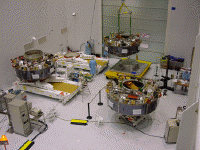 |
|
Unfortunately not all 4 S/C together because the objective was not wide enough even when we tried to climb on top of the clean room ladder |
The last electrical tests on FM 5 have been completed with the execution of the SVT (System Validation Test) with ESOC (European Space Operations Centre in Darmstadt). This was the last SVT test for all spacecraft. ESOC is therefore ready to command the spacecraft and to receive telemetry from them via the Network Data Interface Unit (NDIU).
A unique moment: all 4 spacecraft are together for a short time in the same clean room. This will be the one and only time that this will happen in Baikonur! Then, FM 6 was transferred to the HPF room for the preparation of the second step in the pressurisation operation before the filling operations.
1 June
The battery test equipment has been checked and calibrated before the real start of the activities.
Now, all the pyros for the boom deployment and the RCS (reaction control system) valves have been completed for the FM6 and 7 spacecraft, just on time in view of the battery conditioning and tank filling which will take place next week.
Before the delicate filling operation due to start on June 6, there has been a successful review to ensure that:
- The HPF clean room was fully operational and safe for the filling operation (including checking of the protective `scape' suits and training with them).
- All filling and decontamination procedures were approved both by ESA and by Starsem
- The spacecraft and the ground support equipment were ready for this operation.
31 May
Batteries are also prepared for integration onto the spacecraft i.e they are slowly awakened from their hibernation! They were nicely sitting in their freezer at -15oC and their temperature will be raised from -15oC up to 20oC, step by step over several days.
The batteries are used for power supply during the 4 hour-long eclipse when the spacecraft enters the Earth shadow. Due to the nature of the mission, the batteries are non-magnetic, like all the components of the spacecraft. Therefore, they are not of the classical Ni-Cd (nickel-cadmium) type but made of Ag-Cd (silver and cadmium). They are located inside the spacecraft on the equipment platform in order to ensure a good thermal environment.
The final alignment verification has started for all spacecraft, beginning with FM 6, the front runner spacecraft. These verifications concern mainly the position of all the thrusters and some experiments. It is the last activity for all spacecraft before the battery conditioning and the spacecraft fuel filling.
29-30 May
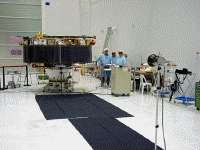 |
|
Flasher tests with from left to right: Wolfram Beckert, Frederick Spaeth and Elizabeth Haeberle from Dornier |
Flasher tests have begun on the first spacecraft (FM 6) in the PPF (Payload Processing Facility) clean room. These tests check the behaviour of the solar panels, which provide electrical power to the spacecraft. The curved solar panels (6 per spacecraft) are attached to the outside of each satellite. During the tests, each solar panel is illuminated and its output power is checked. These tests are performed overnight in order not to disturb the other members of the team.
The FM 6 and FM 7 spacecraft have been transferred to the HPF (Hazardous Processing Facility) clean room for the start of pressurisation ready for fuelling the week after.
27 May
The missing boosters, which arrived the night before, were immediately installed on the FM7 (on 27/5) and FM6 (on 29/5) spacecrafts, after careful unpacking from the explosafe container. Despite the low quantity of powder (around 0.1 gram: the charge equivalent to that of a very small firecracker), they were installed with great care under strict PA supervision, performed by Manfred Schmidt and Arrien Tiemon. The boosters (four gas and two liquid) together with the initiators (one nominal + one redundant) were installed on all the pyrovalves of the RCS system (six per spacecraft in total).
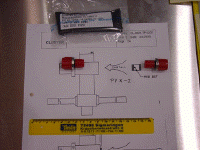 |
|
The gas booster (in bag) with the 2 initiators with the design principle |
The principle of the boosters is a two-stage process: first, one of the initiators is activated then the booster explodes and normally the redundant initiator as well if everything goes all right. This explosion triggers the opening or closure of the valve depending on the design. Obviously, the initiators are for the time being unarmed to avoid any problem. The arming is one of the last operations on the spacecraft and will take place a few days before launch through an access door (hatch) in the fairing of the launcher.
The activities with the installation and the verification of the solar array have started: the flasher test set-up is installed and ready to be operated over night in order to minimise disturbance for the other teams working on the spacecrafts.
26 May night
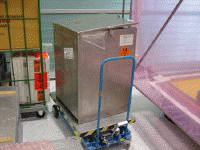 |
|
Explosafe container |
May 26 - 21:30 (local time) was a great moment for the launch team. The explosafe container containing 14 small boosters for the spacecraft was loaded inside our van on the tarmac of Yubileiny airport in Baikonur for transport to the Energia hall, where our spacecraft are prepared for launch. The story started one week ago when these boosters were sent from California to Baikonur to be delivered in the shortest time possible, in order not to jeopardise the schedule of the launch campaign.
The shipment was engineered by Herman Thoma from the Estec Transport and Customs office at Noordwijk, with the support of ESA Moscow office and Starsem for the leg in Russia. First, the boosters were transported by cargo plane from San Francisco to London via Amsterdam. To save time, the box was intercepted at Amsterdam airport and placed inside a special container (explosafe container) to comply with IATA dangerous goods regulations for air transport for the leg in Europe. The customs clearances and the trip from Amsterdam to Moscow were arranged in one day. Once it arrived at Moscow, our troubles started due to the lengthy customs clearance process and the lack of airline communication between Moscow and Baikonur. There are basically only two commercial flights per week from Moscow with little possibility of cargo shipping. There are daily military flights but are usually not available for private companies. After several attempts, it was clear that in the middle of the week, there was no chance to get these boosters in Baikonur before the end of the week. This was in fact the limit for the launch team in order not to affect our schedule. In view of the situation, late in the evening of 25 May, the ESA Cluster 2 project took the decision to arrange a special charter to transport the boosters for the next day. After a long time getting the last custom authorisations to load the container, the charter plane left Moscow at 16:03, local time, which was 3 minutes over the limit for the closure of Baikonur airport. Fortunately, this remained open and manned thanks to the good relations between Starsem and the local authorities. The plane arrived 3 hours 1/4 later at the Yubileiny airport of the cosmodrome where it was welcomed by a small team consisting of Gallina Matthieu and Gerard Gradel from Starsem, Wolfram Beckert from Dornier, our Russian translator and myself (Daniel de Chambure) from ESA. It was quite emotional to see our so long expected boosters arriving in the middle of steppe after such a long journey!
There, the customs clearance with the Kazakhs were conducted in less than 10 minutes, after I confirmed to them that I was the owner of the precious shipment. After a slow drive for half an hour on the bumpy roads of the Cosmodrome, the container was brought to the air lock clean room, where it was opened the next day. After another one hour drive we were back at the hotel around 23:00 where the event was celebrated with a glass of beer!
Unfortunately, there is no picture from this event as the airport is a military one. I tried to ask but I almost got my camera confiscated!
26 May
Every Thursday, work permitting a visit is organised for some of us at the Baikonur Cosmodrome Museum which is close by. The museum is quite interesting and shows the space history of the Soviet Union and now Russia, since its beginning with Sputnik. It covers the creation of Baikonur, the first flight of Joeri Gagarin, all the Proton and Soyuz successes, MIR and Energia-Buran. The recent period with the cooperation with ESA is also not forgotten (MIR mission; microgravity experiment; ISS etc.).
25-26 May
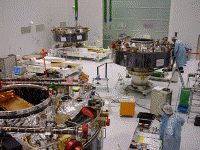 |
22 - 23 - 24 May
This week has seen intense activity, though not very exciting, lots of small mechanical and thermal work to be completed before the end of the week when the first so-called 'hazardous' activities will take place i.e. mounting of the gas booster charges for the pyro-units of the RCS (Reaction Control System) and fuelling of the spacecraft.
In detail, the situation is as follows:
- The FM6 is inside the PPF clean room together with FM7 and FM8. All three are undergoing mechanical and thermal activities, mainly on the RCS. These activities include final torquing of all subsystems, fixing of stand-off for mounting the thermal blankets, thermistor integration, Teflon protection installation on some thrusters and detailed visual inspection.
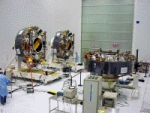
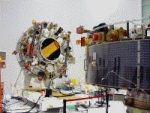
- In the mean time, FM5 currently in the HPF clean room is completing its RCS functional tests (pressure calibration; leak checks; valve functioning, etc.)
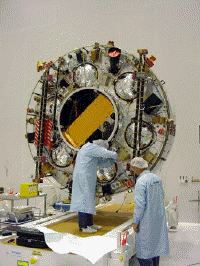 |
|
Torque verification performed by Joerg Mueller (Dornier) under supervision of Arrien Tiemon (ESA) |
Activities have also started to move one of the OCOEs (Operational Check-Out Equipment) and COTEs (Check-Out Terminal Equipment) to the UCIF (Upper Composite Integration Facility) in view of the the mating of the Cluster stack with the Fregat, which should take place at the end of June. This equipment is electrical ground support equipment, for the operation of the satellite. They will be moved once again to the launch pad when the spacecraft will be mated to the launcher and transported to the launch pad.
A nice touch for every member of the Cluster Launch Campaign team who has his birthday during the campaign receives a bottle of vodka. Yesterday, it was Ulrich Woessner (Dornier). Today, it was the turn of Gunter Schuler (Dornier).
10 -20 May 2000
May 20 (evening)
To relax a bit from a long week, we had a small barbecue party at the Sputnik hotel with people from industry and Starsem, organised jointly by the hotel and ESA.
May 20
Several boom deployments have been performed on the FM 7 spacecraft. There are 2 types of booms, which will be deployed once the satellite is in orbit. They include two single-hinged communication antennae, which extend parallel to the spacecraft's spinning axis, and two double-hinged booms on the satellite's upper platform, which deploy radially and carry several experiments.
During the on-ground test deployment, balloons filled with helium are attached to the boom to compensate for the pull of gravity on the boom. No radial or vertical force must be applied on the boom during the deployment.
 |
 |
|
These pictures show the deployment of the experiment boom. The operation is led by Ivady Andras, Abt Georg and Beckert Wolfram from DSS. | |
In orbit, the deployment is triggered by a spring-loaded system, assisted by the centrifugal force of the spinning spacecraft. On the ground, to simulate this centrifugal force, a little fan is also mounted on the boom. This delicate operation takes about = day per boom.
In parallel, activities are starting to set up the equipment for the battery conditioning.
May 19
The spacecraft ballet between the various clean rooms is continuing, with a lot of activities. At one moment, yesterday, there were 3 spacecraft in the Payload Processing Facility (PPF) clean room!
 |
|
The transfer of FM 6 with a specially developed transport carrier |
After completion of the RCS tests, FM 6 has been transferred from the Hazardous Processing Facility (HPF) room to the PPF room for the Spacecraft Verification (SVT) test on a special trolley developed for that purpose. The SVT test took place successfully the same day.
In parallel, thrusters are being remounted on the FM8 spacecraft, which was also moved from the PPF to the Upper Composite Integration Facility (UCIF), after successful completion of the SVT the day before.
In the meantime, the FM 5 spacecraft is in the (HPF) for a Reaction Control System (RCS) functional and leak test.
18 May
- After completion of the RCS tests, FM6 has been transferred from the HPF room to the PPF room for the SVT tests on a special trolley developed for that purpose.
-
An important task, nearing completion, is the final manufacturing of the last batch of the thermal blankets and their verification (conductivity) before mounting on the spacecraft. This long and arduous work (sewing skills required!) is very important for the good operation of the satellites. Despite their known function of providing a good thermal environment to the satellite, the blankets must be electrically conductive to avoid building of electrical charges on the spacecraft, which can be dangerous to the operation of some sub-systems and some experiments. Therefore, the upper layer of the thermal blanket (facing space) is covered with a thin ITO conductive layer, which needs to be accurately verified. Then, once integrated on the spacecraft in June, all the thermal blankets will be grounded to a common point.
Thermal blanket preparation and verification with the Dornier thermal team at work. From left to right: Peter Blaser, Peter Groessner, and Thomas Schmidt.
17 May
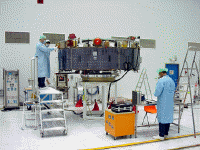 |
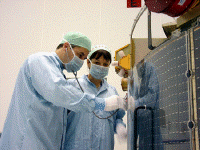 |
- Since yesterday, the winds and the clouds have almost disappeared indicating that the warm season is coming very soon. For the time being, we still enjoy 25 °C daily even with quite cold nights.
- Thrusters have been mechanically and electrically successfully reinstalled on FM5 (even our local Russian doctor and nurse from Europeassistance certified it. Then the satellite was transported from the Upper Composite Integration Facility (UCIF) clean room to the Hazardous Processing Facility (HPF) for verification of the RCS system.
- Spacecraft Verification (SVT) tests on FM7 have been successfully completed: these tests have shown that ESOC is able to control the spacecraft in Baikonur from Darmstadt. These tests are going to be conducted for all the spacecraft end of this week and beginning of next one.
16 May
- The separation springs have been installed on S/C FM8. These springs are mounted on the mechanical interface with the other S/C (FM 5) in order to release/push it once in the correct orbit. The springs are compressed: they are released when the clamp band is activated.
- Spacecraft Verification Testing (SVT) has started on FM7 and is progressing well.
- Reaction Control System (RCS) verification tests are still been carried out on FM6, with the expertise of MMS-UK.
- Thrusters are mechanically and electrically reinstalled on FM5.
14 May (night)
Today, all telecoms links nominal and back-up (between launch pad to ESOC and between site 112 to ESOC) are set up and validated to the great satisfaction of our telecom experts Gerard Melchior and Frederik Wechsler and Starsem. This was nicely celebrated with a glass of champagne at the hotel.
13 May
 |
All the telecom links (nominal and back-up) towards ESOC are being set-up and validated together with Starsem and their Russian partner.
12 May
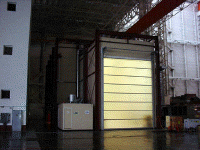 |
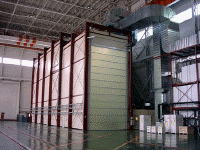 |
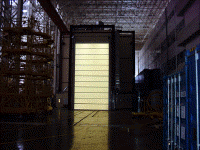 |
|
The three new clean rooms |
- The Payload processing Facility (PPF)
- The Hazardous Processing Facility (HPF) and
- the Upper Composite Integration Facility (UCIF).
All of the electrical verification, the alignment checks, the boom inspection and solar array flasher tests will take place in the PPF.
The HPF is obviously intended for hazardous activities: pressure tests of the propulsion (RCS) system, preparation for spacecraft fuelling and the fuelling itself.
The UCIF will see the final operations on the spacecraft: battery installation, verification and charging; thermal multi-layer insulation installation, installation of the FREGAT adaptor, final electrical verification, spacecraft arming and encapsulation.
Despite being under the same roof, the clean rooms are quite distant from each other (about 200 metres) to allow for hazardous operations in the HPF without interrupting activities in the other two.
Today's status
One spacecraft (FM7) is completing electrical testing in the PPF. FM8 is also in the PPF in stand-by mode after having completed its electrical tests before boom deployment. FM6 is completing Reaction Control System (RCS) verification in the HPF area. FM5 is in the UCIF for thruster installation.
Next week will be an important one with the end-to-end test of 3 spacecraft (the so-called SVT tests) - FM 6, 7 and 8. FM5 will follow the week after.
11 May
Part of the ESA/Dornier (DSS) team got the chance to visit the final integration area of the Buran shuttle on its Energia launcher. Buran and Energia flew 10 years ago, but the programme stopped in 1989 with the introduction of 'perestroika'.
 |
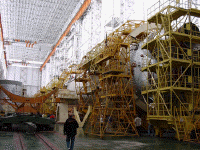 |
As for the Soyuz launcher, all the integration activities are performed in a horizontal position with special U-shaped rigs (or bridges) for performing the various activities (fuelling; mechanical integration; electrical verification etc. Very impressive.
The buildings are about 30-40 metres high and are adjacent to the clean rooms where our four Cluster II spacecraft are prepared.
10 May
Arrival of the third group of ESA/Dornier people under a strong wind, which swept sand over everything on the Baikonur airport. This wind, called "Bizkounak" in the Kazakh language, has lasted 4-5 days and indicates that the mild season is finishing and that the hot one is coming.
27 April - 4 May 2000
Over the coming weeks, members of the ESA Cluster II project team will be sending regular entries for the launch campaign diary from Baikonur in Kazakhstan. These first entries were logged by the Launch Campaign Administrator, Looc Bourillet.
Thursday 4 May
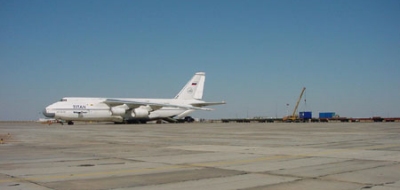 |
|
The Antonov returns in the evening with the second pair of spacecraft (FM 5 and FM 8) and ten more containers loaded with equipment. |
The late arrival of the Antonov means that unloading cannot start until the following day.
Monday 1 May
A well deserved rest for everyone? Well, not quite. The 'telecoms' experts (G. Melchior, F. Wechsler, M. Gottschlich) go to the base to continue setting up the telecommunications.
The mountain bikes available at the hotel are very much appreciated and most useful in exploring the town of Baikonur as well as the immensity of the surrounding Kazakh steppe.
Sunday 30 April
Due to the closure of the Cosmodrome on 1 May, this Sunday is also a working day for all of the team. Surprisingly enough, some of our Russian partners came dressed in orange suits, as if they knew about the Dutch Queen's birthday!
Unloading activities go on and the whole team succeeds in completing it, though not without a fair amount of perspiration!
All of the office furniture, stationery, computers etc. have been brought into the office.
Saturday 29 April
Saturday is a normal working day for the launch campaign team. Unloading of the spacecraft container can begin after it is transferred to site 112.
At the Baikonur airport, the 2 spacecraft containers and all the equipment were hoisted out of the Antonov plane and then transported by train to the Baikonur Cosmodrome about 40 km away.
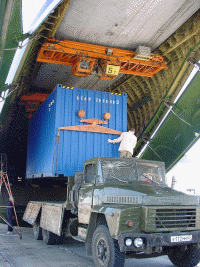 |
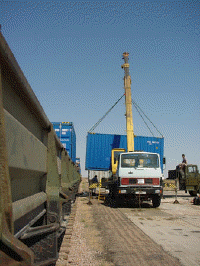 |
|
Hoisting the spacecraft containers out of the antonov (left) and transport to the Baikonur Cosmodrome (right). | |
Friday 28 April
First transfer to the working site by bus. Departure from the hotel at 07.30, arrival at site 112 (Starsem working areas) at 08.15.
The first cargo plane landed at 10.45 (local time), using the same runway as the Russian shuttle Buran during its maiden flight. The plane is an Antonov 124, a real flying monster, with a much larger belly than a Boeing 747. Unloading activities went on very efficiently until late afternoon.
Thursday 27 April
Transfer of the first Cluster II launch campaign team from Moscow to Baikonur. 33 people in total, comprising staff from Dornier Satellitensysteme, Matra-Marconi Space, TGI (spacecraft support), Europassistance (medical support), Starsem (launch services) and ESA.
Arrival in Baikonur on time. Blue sky. Usual wind (about force 3 - 4). Outside temperature 27 °C.
After Kazakh customs clearance ( 1 to 1½ hours) most of the team have their first look at the city of Baikonur during the transfer by bus to the Sputnik hotel.
After a general presentation by Starsem, everybody is ready in the starting blocks to launch the campaign!






